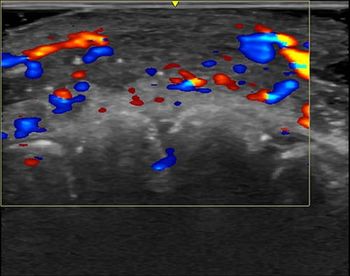Emerging research suggests that reassessment of breast magnetic resonance imaging (MRI) identified as high-risk by artificial intelligence (AI) may lead to significantly improved detection of early breast cancer.
For the retrospective study, recently published in Academic Radiology, researchers evaluated the capability of a convolutional neural network, trained on breast MRI, for predicting the development of breast cancer within a year of negative breast MRI results. Drawn from a dataset of 3,029 MRI from 910 patients (mean age of 52), the cohort was comprised of 115 cases of breast cancer diagnosed on MRI. All patients had an initial BI-RADS assessment of < 3, according to the study.
For the prediction of breast cancer within one year, the researchers found that the AI model had a 72 percent area under the receiver operating characteristic curve (AUC). For initial MRI scans, there was a visual correlation in 83 of 115 cases that progressed to biopsy-proven breast cancer, according to the study authors, who added that the majority of visual correlates were < 0.5 cm.
The researchers also emphasized that reassessment of breast MRIs identified as high-risk by the AL model may have led to upward of a 30 percent improvement in early detection of breast cancer.
“It is important to note here that the sensitivity of 30% reported here are for cancers that would have remained otherwise undetected until the next exam. They are additional cancers above and beyond those that have already been detected with high sensitivity by the radiologist,” wrote lead study author Lukas Hirsch, Ph.D., who is affiliated with the City College of New York in New York, N.Y., and colleagues.
Noting current positive predictive value (PPV) benchmarks of 15 percent for tissue diagnosis and 4.4 percent for abnormal interpretation, the study authors said the aforementioned 30 percent sensitivity would be associated with a 6 percent PPV for reassessment of MRI scans deemed at high-risk by the AI model.
Three Key Takeaways
1. AI-enhanced early detection. The reassessment of breast MRIs flagged as high-risk by an AI model may lead to a 30 percent increase in early breast cancer detection, helping identify cases that might have gone undetected until the next screening.
2. Improved localization. The AI model accurately identified the future location of breast cancer in 57 percent of cases, which could support radiologists in pinpointing areas for closer examination and follow-up.
3. Enhanced positive predictive value (PPV). By re-evaluating AI-identified high-risk MRIs, radiologists could potentially increase the detection of clinically significant tumors by at least 15 percent.
“If radiologists recalled only half of these re-evaluated cases, they would approximate the recommended PPV for tissue diagnosis, and detect at least an additional 15% of tumors, which is a clinically meaningful improvement,” maintained Hirsch and colleagues.
The study authors also noted that the AI model correctly identified the location of future breast cancer in 66 of the 115 cases (57 percent). For 35 true positive cases, the researchers maintained that the AI model correctly identified the localization of breast cancer in 25 cases (71 percent).
(Editor’s note: For related content, see “Can Multimodal AI Enhance Prediction of Axillary Lymph Nodes Beyond MRI or Ultrasound-Based Models?,” “AI Mammography Platform Shows Promising Results for Detecting Subclinical Breast Cancer” and “Enhancing Lesions on Breast MRI: Can an Updated Kaiser Scoring Model Improve Detection?”)
Beyond the inherent limitations of a single-center retrospective study, the authors acknowledged the assessment of MRI being limited to sagittal scans and conceded the small number of screen-detected breast cancers.





























